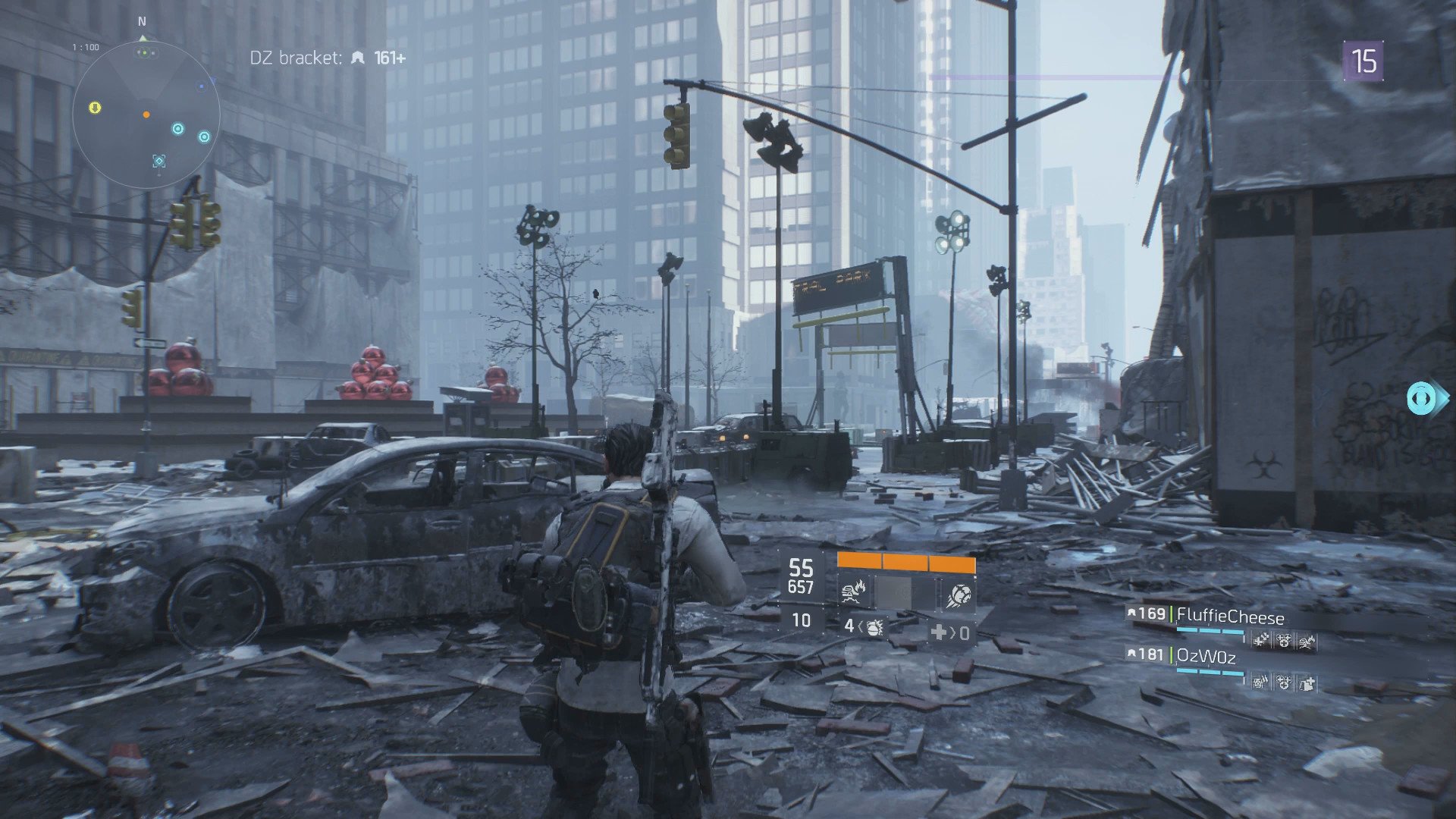In the post-Destiny world of the MMO-lite, Tom Clancy's The Division represents a massive ambition to combine a modern third-person tactical shooter with RPG mechanics in a huge and connected world. Ubisoft's industry leading open-world design takes center stage, painstakingly reconstructing New York City wrapped in a near-apocalyptic vision of social breakdown.
I've spent almost 100 hours stalking The Division's alleyways, abandoned buildings, and contaminated sewers. It'd be a lie to say that Ubisoft Massive's connected shooter isn't a huge achievement.
Millions of players have fully engaged. They've spent days grinding out gear, trying to perfect character builds and taking on the game's most daunting challenges. At this point, I've seen everything The Division has to offer. I want to answer the question 'is it all worth it?' This is the full experience of The Division.
Virulent Vistas
Story, Setting and Design
The Division is based on a real-world simulation that shows how rapidly society would break down in the event of a biblical-scale viral outbreak. Taking place in a meticulously detailed reconstruction of New York City, a secret U.S. military organization known as the Strategic Homeland Division, or simply 'The Division,' is activated to respond to the catastrophe, which has brought the United States to its knees and chaos to the streets.
You play as a voiceless Division agent, whom you can customize visually to a limited degree. Your agent is deployed to investigate the cause of the outbreak, help the terrified survivors, and combat the city's opportunistic criminal elements.
MMO-lites and their derivatives aren't particularly renowned for their stories, and The Division doesn't go to great lengths to buck this trend. While the premise is exciting, the story's delivery could've been a little more ambitious. There are very few cut-scenes, and they typically take place in the safety of your home base during debriefing conversations. There are no cinematic set-pieces, no major plot twists, and in typical Ubisoft-style, the opportunity to develop the game's limited array of villains is sorely missed.
All the latest news, reviews, and guides for Windows and Xbox diehards.
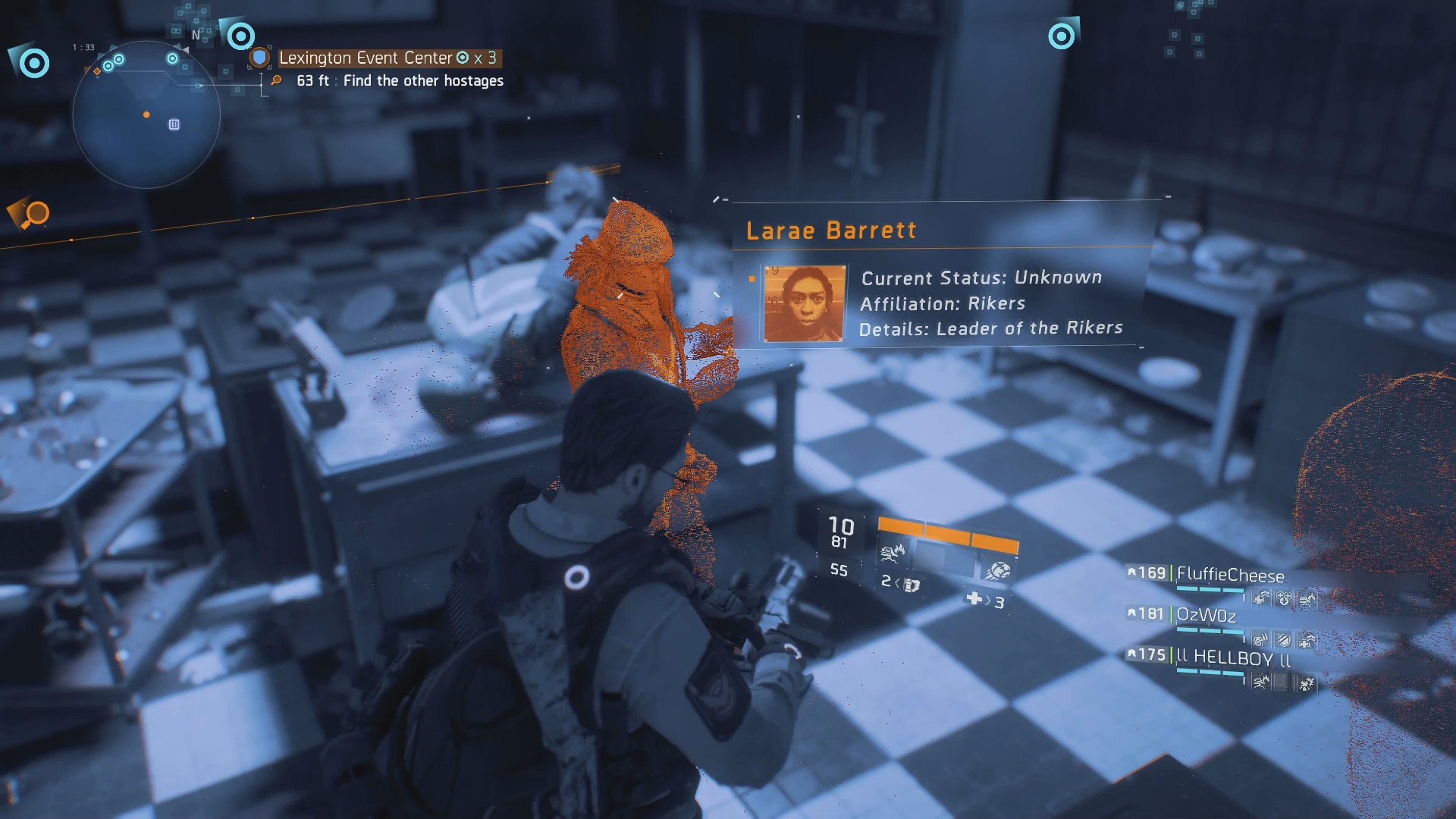
Taking on a real-world setting for this type of game has clearly been a challenge. There are no zombies, fantasy creatures or aliens to give the world flavor, so to under-develop the narrative surrounding the game's enemy factions comes across as unusually stark. Why did hundreds of city sanitation workers become insane, murderous pyromaniacs? How was one person able to rally scores of prison inmates into an organized militia? There are answers to some of these questions, but Ubisoft makes you dig for them. Much of the game's narrative and character development is hidden away in collectable CCTV footage, mobile phone recordings or 'Echo' events, which show you scenes from a prior event in augmented reality.
The vast amount of narrative items does help to give the game's world some believability. There's an immersive Watch Dogs-like voyeurism about going through a discarded cell phone or abandoned CCTV clip, seeing glimpses of The Division's virtual inhabitant's lives. There are hundreds of them too, giving completionists a lot to think about.
I can appreciate that Ubisoft probably felt that going heavy on the cinematics and narrative in a primarily multiplayer game could've been wasteful, but its weak presence dampens the roleplaying investment you might typically look for in an RPG, and reminisces of similar failings found in their other AAA franchises. At the very least, it not only makes any attempt at playing The Division solo a pretty soulless affair, it feels like a missed opportunity to elevate expectations of what a massively multiplayer game can and should achieve on the narrative front.
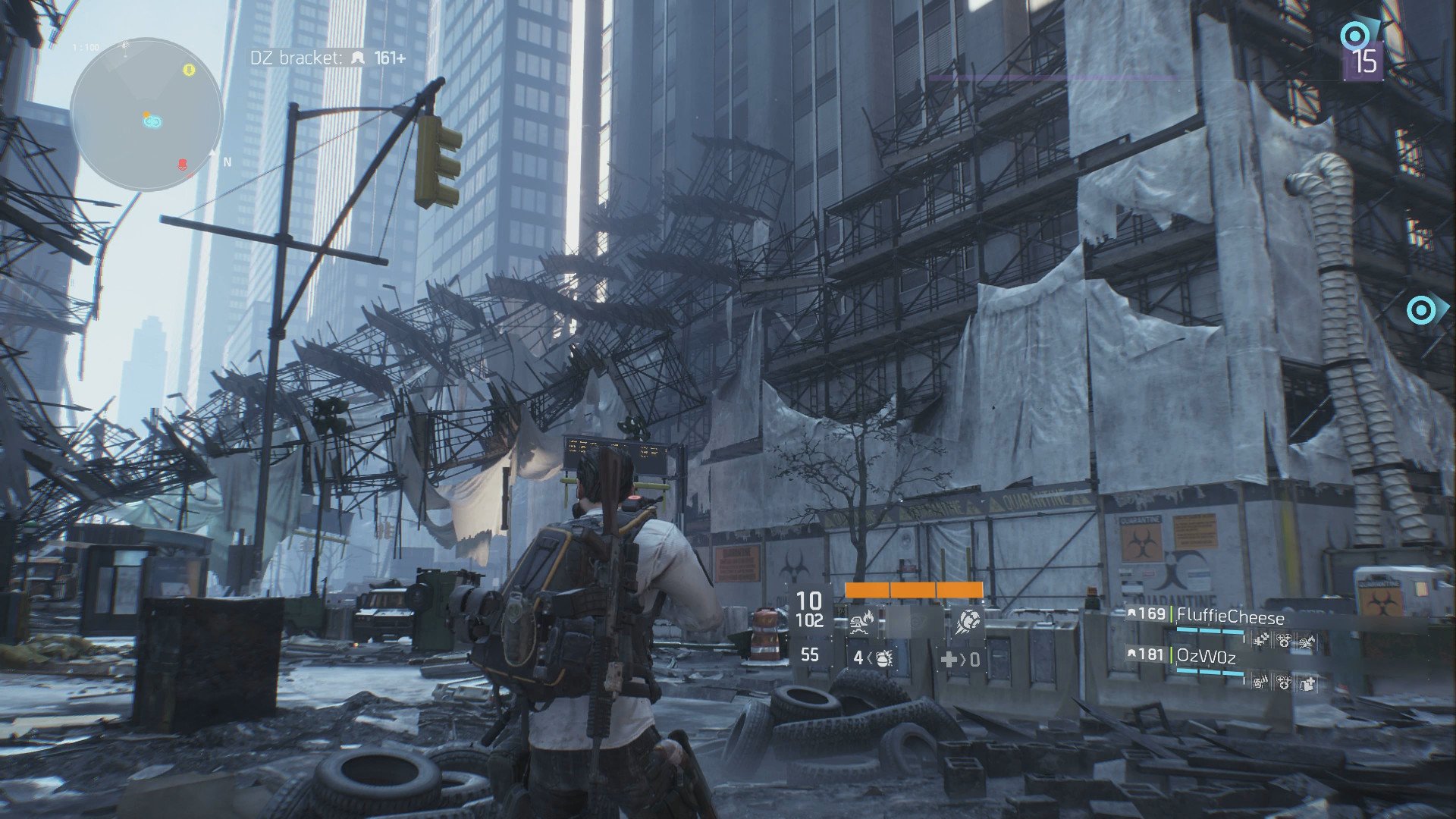
Where immersion through story might be lacking, the same cannot be said for The Division's graphics. The visuals are one instance where Ubisoft shrugged off the typical MMO design conventions of reduced graphical quality to favor sheer volume – The Division is one of the most beautiful titles available on the Xbox One today. From its dynamic weather systems, densely detailed locations, and lavish special effects, The Division is the triumphant culmination of Ubisoft's industry-leading open world design.
The Division grasps at the periphery of an engaging story with its optional narrative footage, but it's a far cry from the lore-stuffed cinematic missions that feature in other open world RPGs. The result paints The Division as a visually exciting, but ultimately static diorama.
Ubisoft Massive's take on the RPG shooter genre more than makes up for its brief story treatment with some incredible core gameplay, the foundation of which could prove to be a winning formula that ensures The Division's survival for years to come – but it isn't without problems.
Loot Fever
Gameplay
As noted, The Division is a connected RPG cover shooter, set in the third person. The game has heavy co-operative elements, and purports to encourage class-based, strategic co-operative play – a prospect that should prove particularly rewarding in some of the game's harder activities.
The Division draws parallels with the likes of Diablo III and Destiny, undergoing a gameplay shift between the levelling experience and its post-story endgame content. The initial Level 1-to-30 experience is one of discovery, skill unlocks and plot progression while Level 30+ becomes a loot hunt, providing increasingly difficult challenges for increasingly powerful items.
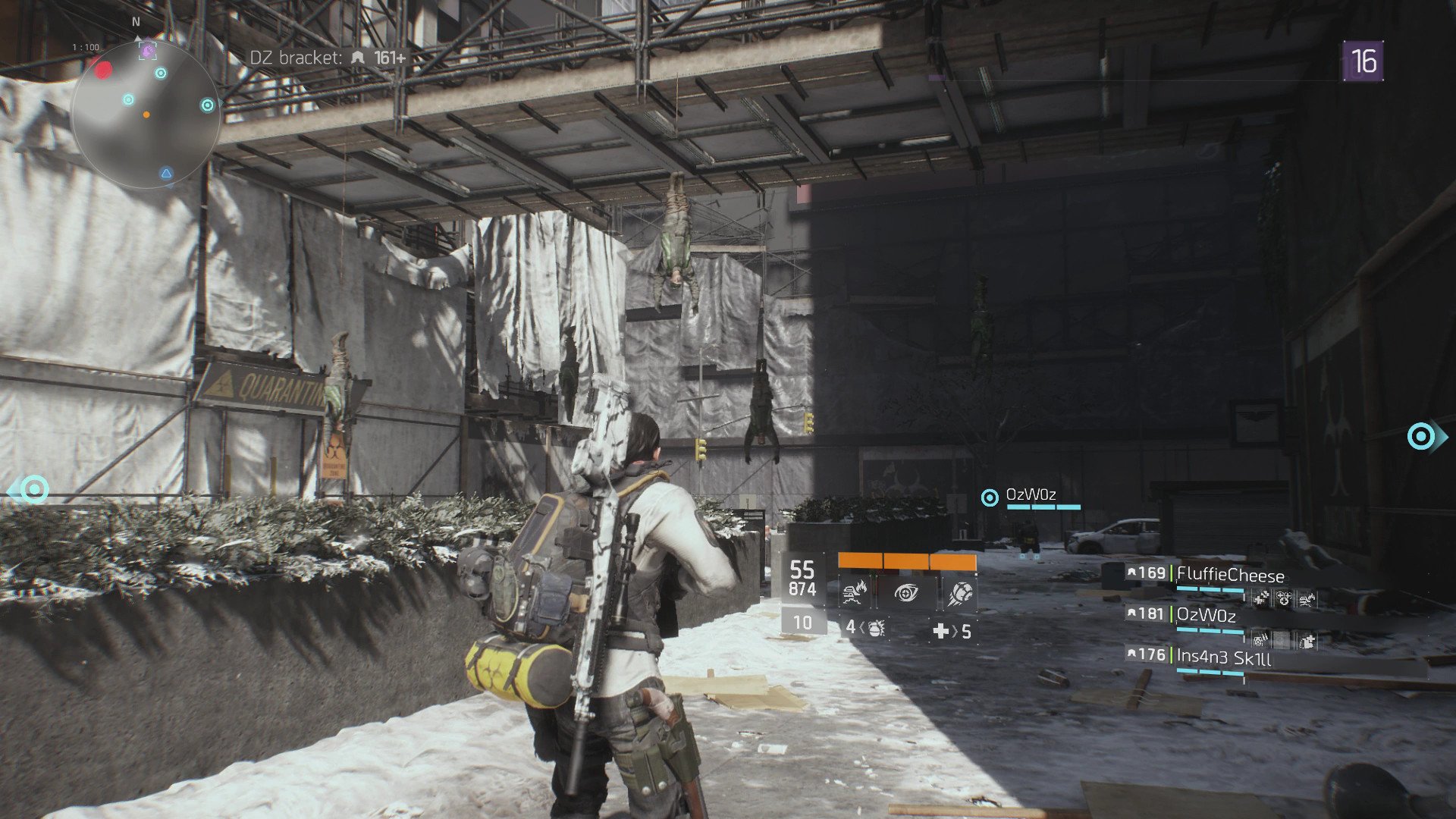
Level 1 to 30
As I begun playing The Division for the first time, I felt a twinge of excitement I hadn't felt since the early days of World of Warcraft. Exploring the game's abandoned buildings, quarantined labyrinths and haunting makeshift mortuaries proved a sobering experience, given the fact it's set in near-modern times, and based on events that could theoretically occur.
While the locations are varied, detailed and gorgeous, the mission objectives you're required to undertake while levelling are woefully unambitious. Accompanied by very sparse context, they almost always amount to the following. "Go to this waypoint, stand here, kill a bunch of gun-toting dudes, get experience points, move on to the next."
Despite the game's incredible atmosphere and brilliantly executed enemy A.I., the copy-and-pasted mission objectives make for a crushingly simplistic solo experience. Perhaps that's fair enough, though; The Division isn't designed to be played alone.
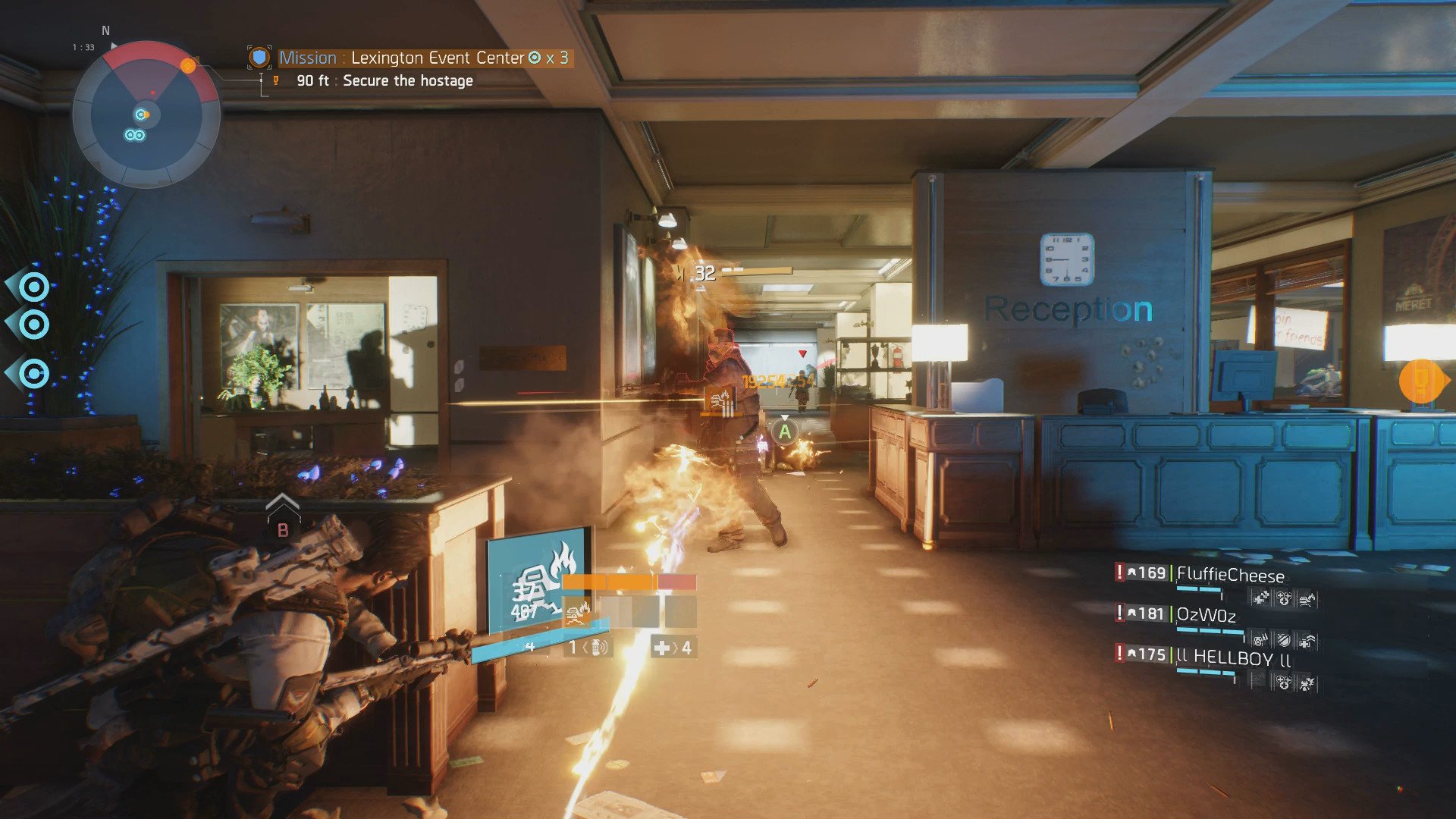
Similarly to Diablo 3 and Borderlands, squads of up to four players can jump into each other's game world, complete missions, explore and obtain loot together. Enemies scale dynamically to account for the additional damage your squad will be dealing – and this is where The Division is the most enjoyable.
The core objectives outlined above are far more engaging when tackled in a squad. In the earlier stages of The Division, the game feels well tuned to reward players who want to commit their skills to a healer role, a damage role or a defensive tanking role in equal measure. At this point, it's nowhere near as restrictive as a typical MMO, where you simply can't progress in a mission without a particular skill utility or class function.
Beyond strategic play, The Division rewards players with piles of color-coded loot items. As I was levelling up, every boss kill and every hidden cache scattered throughout the game's winding and vertical open world provided heaps of gratifying upgrades.
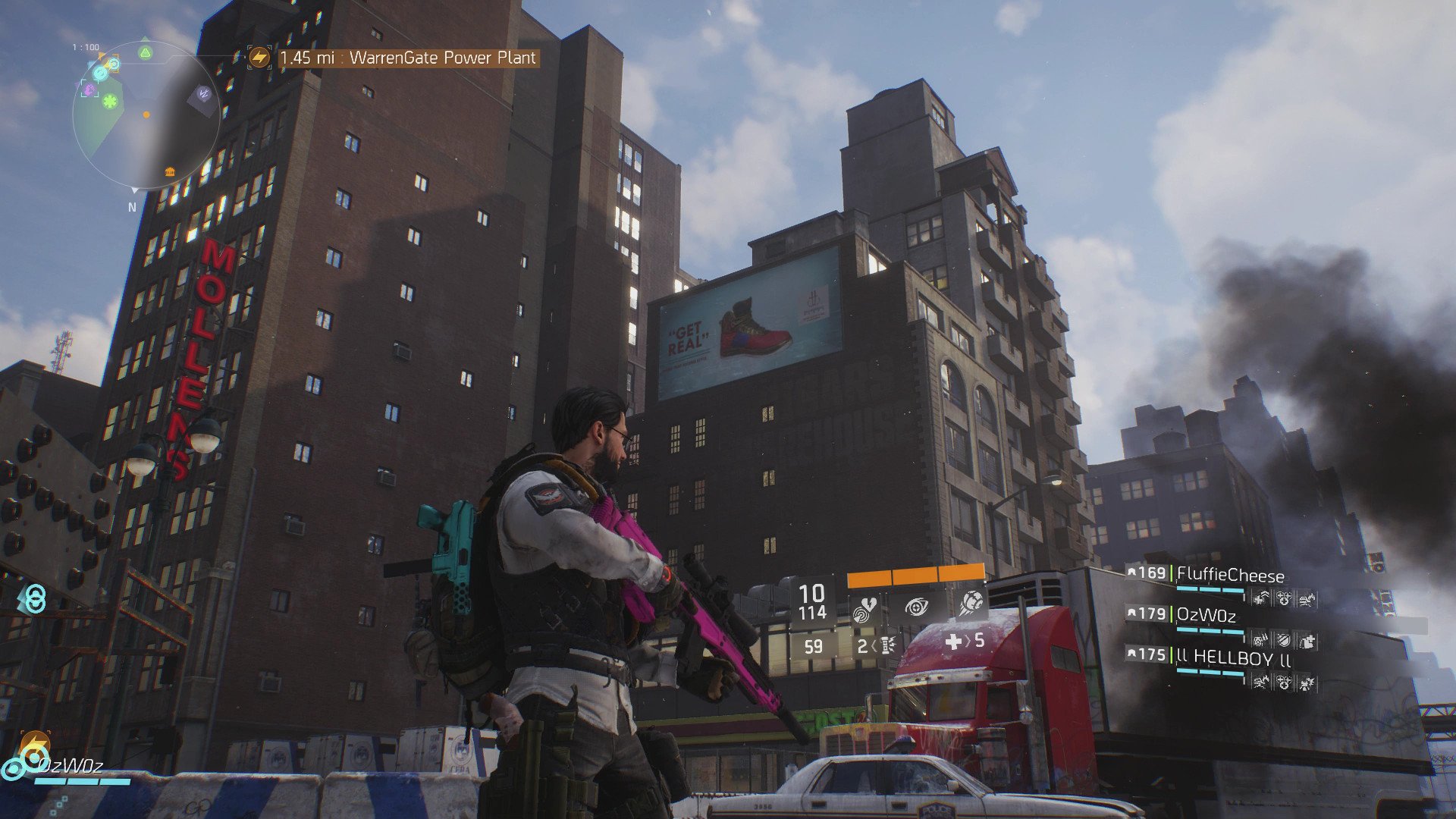
The Division's varied weapon types also feel great to use, particularly when combined with the diverse modding and gear talent system which adds layers and layers of customization and ways to progress your character.
As I was levelling, The Division felt as though it had nailed all the magical elements of a strategic shooter RPG, with meaningful upgrades, class skills, and intelligent enemy CPU behaviour. Indeed, as a shared experience, The Division very effectively provides dozens of hours of co-operative RPG shooter fun for groups of friends – making it a worthy proposition in its right.
However, if you want to dive deep into The Division's endgame, a lot of the systems that appear robust at face value begin to unravel.
Level 30 Endgame
After slugging through The Division's open world levelling content, you'll start peeling away at layers of increasingly loose design decisions that hinder the Level 30 endgame. Only four of the game's dungeon-like missions are available to be set as a Level 30 challenge mode, edging the post-story gear grind into repetitive territory. While The Division's much-touted Dark Zone area provides a wealth of variety as a result of player-driven emergent PvP play, even these areas of the game are marred by flaws in some of the game's underlying systems.
The vast majority of The Division's abilities simply aren't valuable enough in the highest Level 30 PvE or PvP content. While it felt as though The Division had playstyle diversity levelling up, it's simply not an option to play as an aggro-stealing tank or a pure DPS role in The Division's endgame – despite having gear stats that hint at the contrary. The most optimal builds in both PvE and PvP are defensive healer hybrids to ensure personal survival, minimizing the need for co-operative and strategic play, and maximising the need to coordinate the spam of the game's most powerful defensive abilities on cooldown while ignoring the game's robust cover system, strafing and dodge rolling instead. Other playstyles struggle to make the grade.
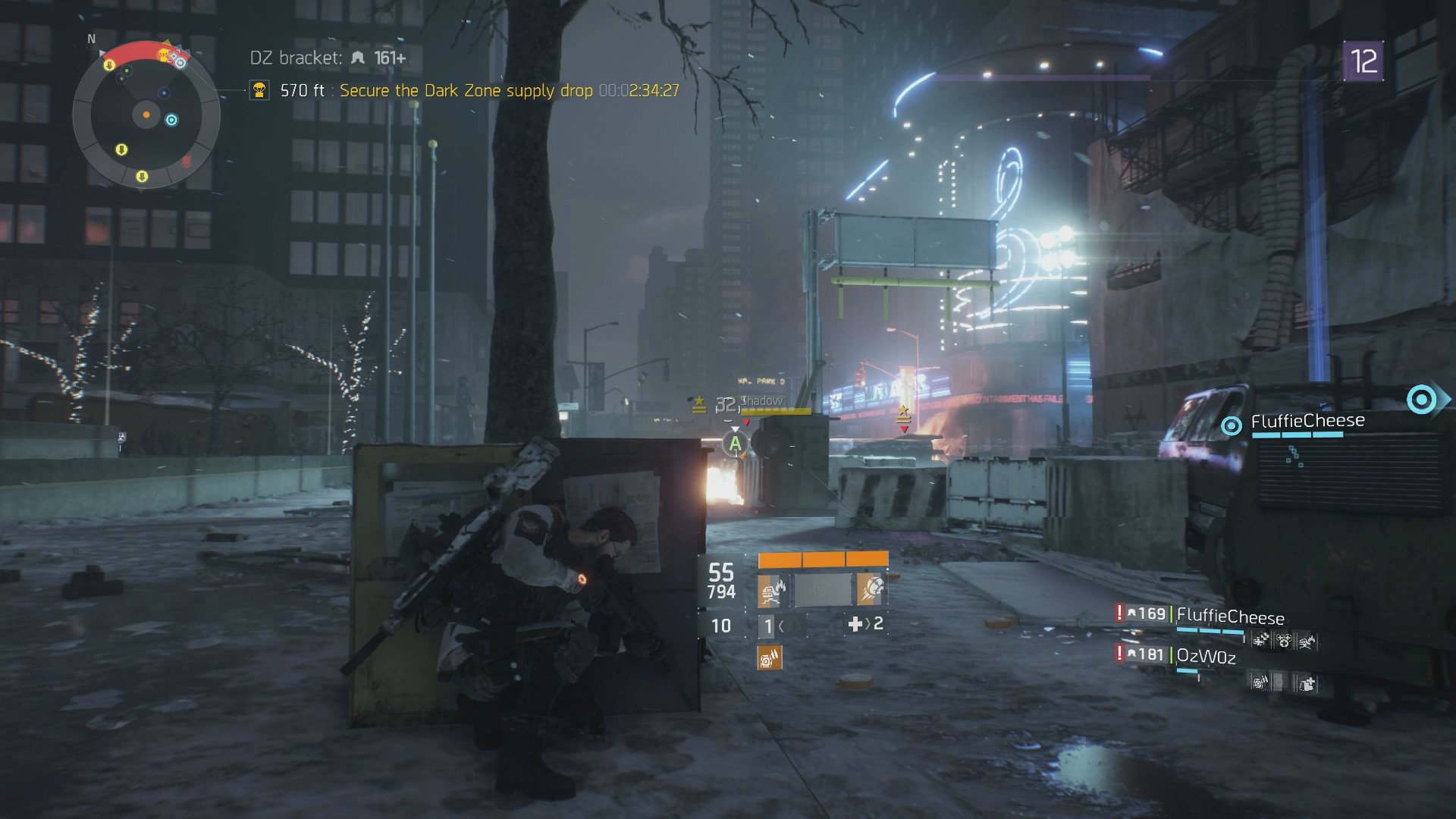
On the PvP side of things, if you don't want to suffer endlessly repeating the game's four challenge mode missions, as mentioned, you can step into the Dark Zone – which features NPC bosses, hidden caches of wildly powerful gear and other players. And yes, they can kill you. In fact, they often will. Until you've successfully extracted gear obtained in the Dark Zone, you will drop items you're carrying when killed. Extractions can only be triggered in certain areas, they alert nearby players to your presence, and take over a minute to complete – making for harrowingly tense situations. My first forays into the Dark Zone were exhilarating, even when you disregard the sluggish server infrastructure.
Successfully extracting the awesome loot you've obtained in the Dark Zone always feels so good.
Gear has a far more pronounced effect in the Dark Zone than it does in comparable shooters. A player who has maxed out all the endgame content on offer can very easily destroy a player who is stepping into the highest Dark Zone level bracket for the first time, making PvP encounters pretty meaningless on a competitive basis. It contributes to the exciting sense of danger and vulnerability you'll feel in the Dark Zone, as most of the time you'll be unable to determine how powerful a potential enemy player is just by staring at them.
Will they kill me? Do they simply want to utilize the loot extraction chopper as well? Will they attack as soon as my back is turned? Those paranoid questions make for exciting experiences, as squads of players will often meet in Mexican standoffs, testing each other's nerves – and of course, successfully extracting the awesome loot you've obtained in the Dark Zone always feels so good.
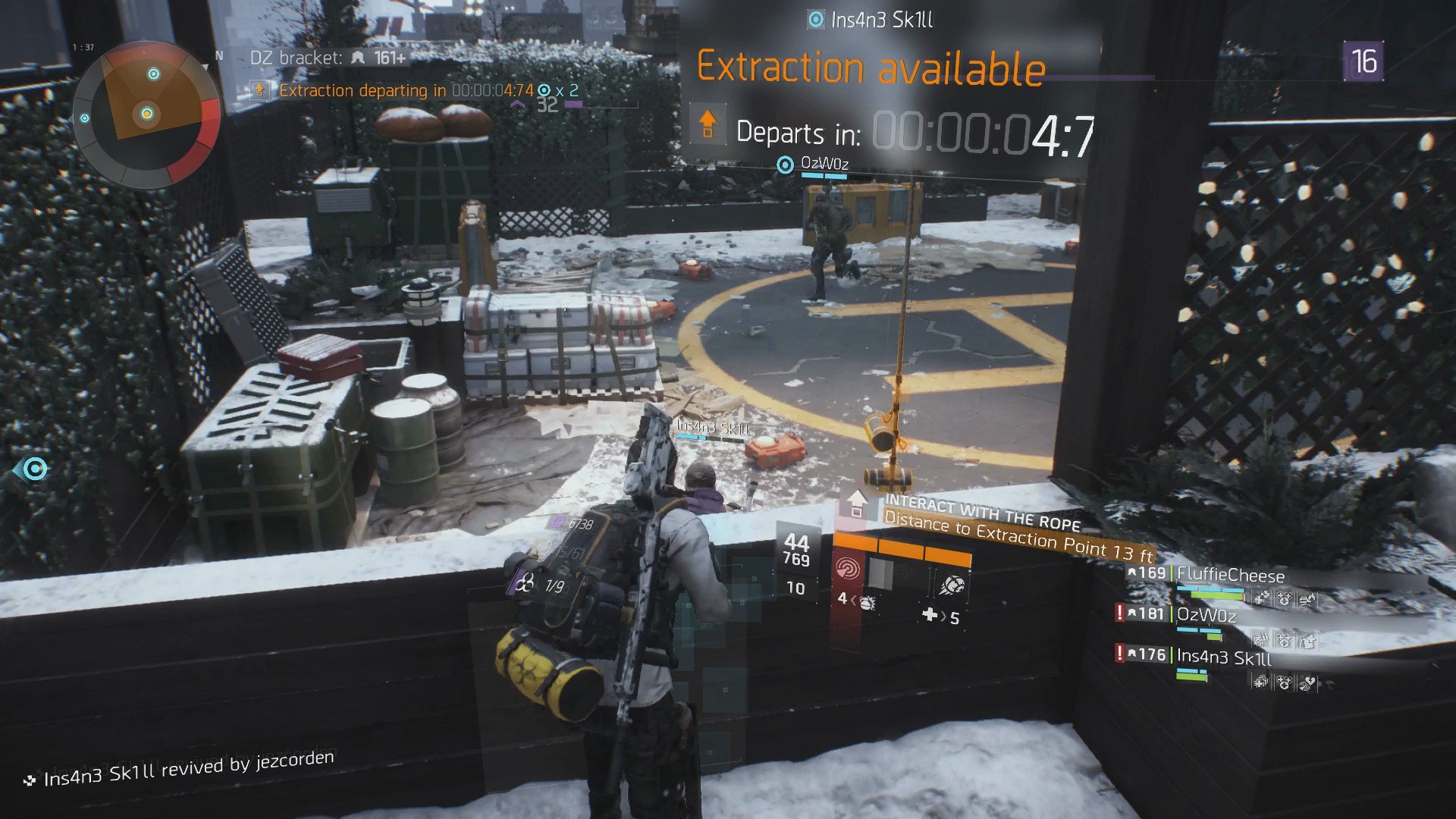
As noted, far too many of the game's skills and talents are weak in player vs. player combat. Encounters devolve into opposing squads chain-spamming the game's most powerful abilities, ignoring the advertised cover system to strafe and roll while hip firing sub-machine guns. Despite the sadistic gratification of insta-killing under-geared players, the Dark Zone's chaotic implementation results in limited satisfaction for anyone looking for serious player vs. player action. It wouldn't be a major problem if The Division featured truly balanced PvP gameplay modes or a robust PvE progression path without the Dark Zone, but the lack of Level 30 activities makes participation unavoidable.
The imbalanced ability tuning extends into The Division's highest-level PvE endgame content too — the incursion 'Falcon Lost' – which is a brief, wave-based boss fight taking place in a single arena.
It's laudable that Ubisoft is providing endgame players new challenges in free updates, but Falcon Lost exemplifies some of the game's most deep-seated issues. The sheer amount of area of effect attacks, combined with swarming drones that fly above cover, and The Division's weak crowd control abilities once again render various skills, class roles, and even the cover system suboptimal.
The most popular strategy for overcoming 'Falcon Lost' involves hiding in a coverless trench to negate the stationary boss, with all four squad members chaining the overpowered Survivor Link ability and area of effect healing skills to mitigate incoming damage. Of course, it's the player's choice to commit to this sort of cheesy strategy, but when it's the easiest path to victory it just feels inefficient not to utilize it. Being forced to play this way feels unsatisfying, and makes me wonder whether future Incursions will be similarly short-lived.
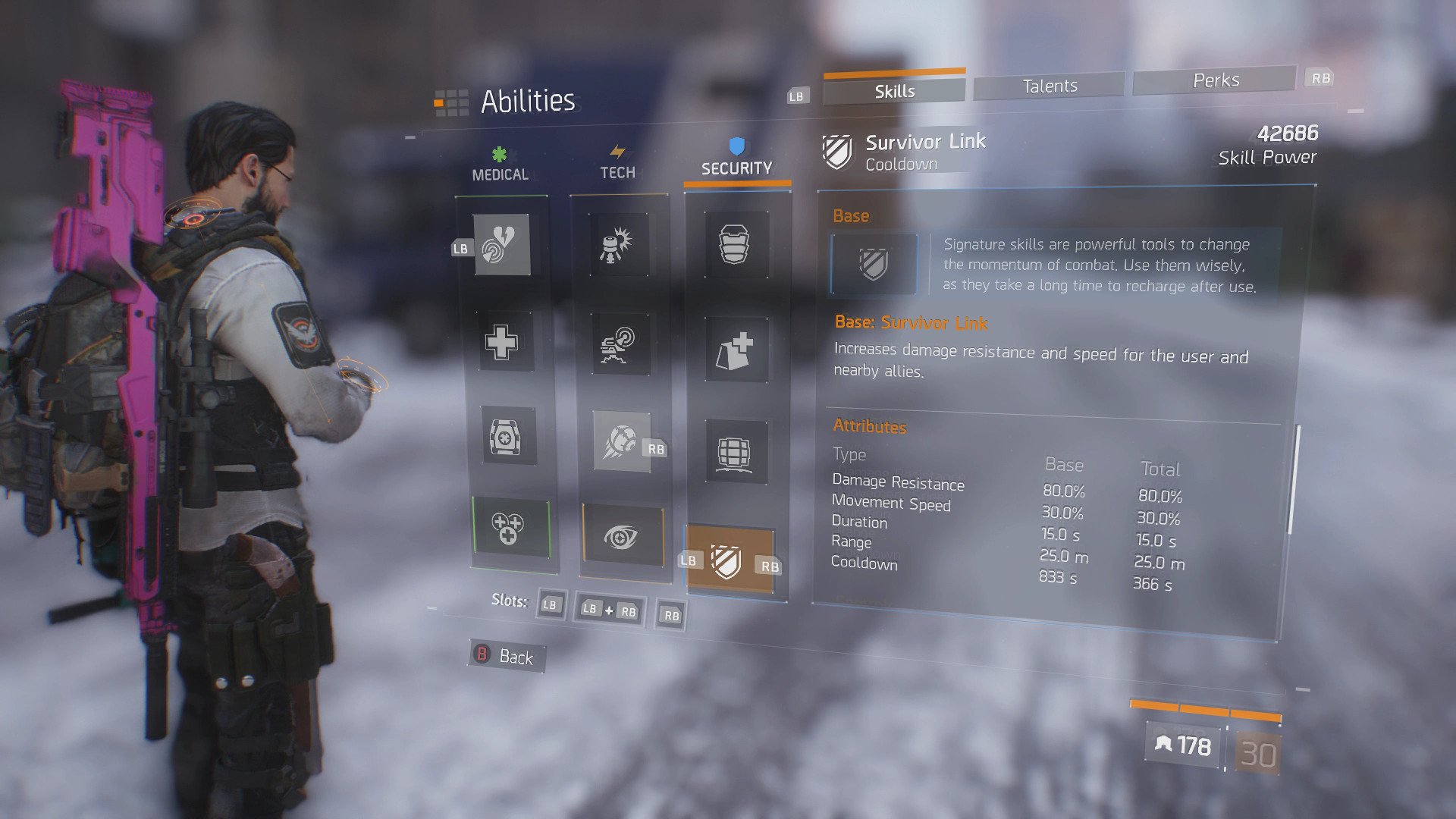
Perhaps a greater diversity of playstyles would emerge if the loot system wasn't so unbearably random.
Perhaps a greater diversity of playstyles would emerge if the loot system wasn't so unbearably random. Each piece of endgame loot features the usual stats that improve damage, survivability, tech skills and so on, but they also feature a vast array of nuanced sub-stats that strengthen specific abilities, such as improved turret health, damage resistance against elite enemies, and much, much more. Obtaining those stat boosts is based on pure randomness, and while you can spend credits (a LOT of credits) to re-roll them, far too often you won't actually get the stats you're gunning for.
For all the dissatisfaction, The Division is still more than enjoyable to jump on with friends to complete the daily challenge mode missions, suffer together in the anarchy of the Dark Zone, and grabbing powerful loot always feels great. The way the studio has designed play for Level 30+ reveals flaws in the game's design that may even call for an overhaul of some of its systems. Ubisoft says its listening to feedback, but whether or not players will receive the updates they need is, of course, uncertain.
Post-Apocalypse
Conclusion
Tom Clancy's The Division has been a frustrating game to review – not because it's a bad game, far, far from it – but because it comes so close to being something truly amazing.
While the elements of something incredible are certainly present, from the industry-leading world design, sobering atmospherics, detailed environments, creative skills, and the conceptually exciting Dark Zone – the implementation has been far from ideal, even when you disregard annoyances like disappearing daily missions and insufferable Dark Zone lag.
Pros:
- Industry leading visual design
- Polished combat mechanics
- Unlimited potential
Cons:
- Story delivery is weak
- PvE content is thin
- RPG skills and systems need attention
If you haven't jumped into The Division yet, it's a fantastic title for groups of friends seeking a straight-forward, Diablo-like experience wrapped in a robust and polished RPG cover shooter. If you're looking for endgame content that's a little more MMO-like with its depth and diversity, I'd recommend waiting to find out how the free upcoming Patch 1.2 alters the state of play. Ubisoft has hinted that it plans to improve weaker skills and develop the game's PvE offering, but whether or not they deliver remains to be seen.
Ubisoft hasn't built a title like this before, and the inexperience clearly shows – The Division seems to be a victim of its ambitions. The good news is that now, games can be updated, and the flaws in the system aren't so thick that they're beyond repair. With proper attention, Ubisoft could easily pivot the game towards the vision it represents. We can only hope that The Division's long-term story is just beginning.
This review was conducted on Xbox One using a copy purchased by the writer.

Jez Corden is the Executive Editor at Windows Central, focusing primarily on all things Xbox and gaming. Jez is known for breaking exclusive news and analysis as relates to the Microsoft ecosystem while being powered by tea. Follow on Twitter (X) and tune in to the XB2 Podcast, all about, you guessed it, Xbox!
